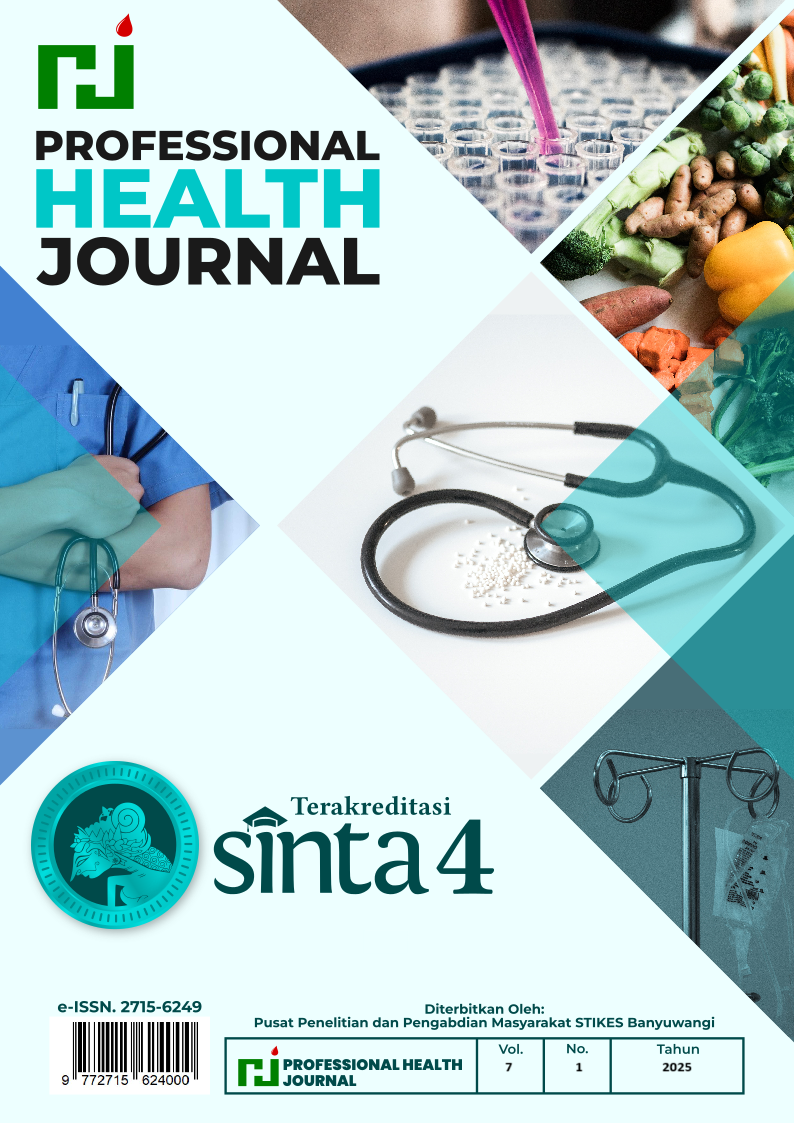Differences in the Incidence of Anemia in Acceptors of 1-Month Injection and 3-Month Injection Contraceptives
DOI:
https://doi.org/10.54832/phj.v7i1.954Keywords:
Contraceptive use, family planning, reproductive healthAbstract
Background : Anemia is a condition in which there is a reduced number of red blood cells or a lower concentration of hemoglobin within them. Injectable contraception is the most widely utilized hormonal option. Research clearly indicates that heavy or prolonged menstruation serves as a major trigger for iron deficiency anemia in women of childbearing age. The 1-month and 3-month injectable contraceptives contain hormones that notably affect menstrual patterns. This study aims to analyze the differences in the incidence of anemia between users of the 1-month and 3-month injectable contraceptives. Method : This research method is observational analytic design with a comparative approach. The number of sample is 62 injectable contraceptive users, selected through consecutive sampling techniques. Hemoglobin levels were carefully examined as the measurement instrument. Data analysis was conducted using the Independent sample t-test and Chi-Square. Results : The results clearly demonstrate that among users of the 1-month injectable contraceptive, the majority exhibited regular menstrual patterns (40.3%). In contrast, most users of the 3-month injectable method experienced secondary amenorrhea (43.5%). Additionally, a significant proportion of respondents were found to be non-anemic (64.5%). The Independent sample t-test revealed a p-value of 0.025 (p < 0.05). The chi-square test presented a p-value of 0.598 (>0.05). Conclusion : There is a difference in hemoglobin levels in acceptors of 1-month and 3-month injectable contraceptives. There is no difference in the incidence of anemia in acceptors of 1-month and 3-month injectable contraceptives.
Downloads
References
Dinas Kesehatan Indonesia. (2023). Profil Kesehatan Indonesia 2023.
Dinas Kesehatan Kabupaten Sidoarjo. (2023). Profil Kesehatan Kabupaten Sidoarjo 2023.
Dinas Kesehatan Provinsi Jawa Timur. (2023). Profil Kesehatan Jawa Timur 2023.
Baldwin, M.K. et al. (2023) ‘Hormonal therapies in females with blood disorders: thrombophilia, thrombosis, hemoglobinopathies, and anemias’, Research and Practice in Thrombosis and Haemostasis, 7(4), p. 100161. Available at: https://doi.org/10.1016/j.rpth.2023.100161.
Britton, L.E. et al. (2020) ‘CE: An Evidence-Based Update on Contraception’, AJN, American Journal of Nursing, 120(2), pp. 22–33. Available at: https://doi.org/10.1097/01.NAJ.0000654304.29632.a7.
Donnez, J. et al. (2022) ‘Uterine disorders and iron deficiency anemia’, Fertility and Sterility, 118(4), pp. 615–624. Available at: https://doi.org/10.1016/j.fertnstert.2022.08.011.
Enggoe, N.H. et al. (2022) ‘Status Gizi, Jenis dan Lama Pemakaian Alat Kontrasepsi Pil, Suntik 1 Bulan dan Suntik DMPA dengan Gangguan Menstruasi’, Journal of Telenursing (JOTING), 4(2), pp. 618–626. Available at: https://doi.org/10.31539/joting.v4i2.3848.
Gallo, M.F. et al. (2008) ‘Combination injectable contraceptives for contraception’, Cochrane Database of Systematic Reviews [Preprint]. Edited by Cochrane Fertility Regulation Group. Available at: https://doi.org/10.1002/14651858.CD004568.pub3.
Haamid, F., Sass, A.E. and Dietrich, J.E. (2017) ‘Heavy Menstrual Bleeding in Adolescents’, Journal of Pediatric and Adolescent Gynecology, 30(3), pp. 335–340. Available at: https://doi.org/10.1016/j.jpag.2017.01.002.
Haile, Z.T. et al. (2017) ‘The relationship between history of hormonal contraceptive use and iron status among women in Tanzania: A population-based study’, Sexual & Reproductive Healthcare, 13, pp. 97–102. Available at: https://doi.org/10.1016/j.srhc.2017.07.003.
Hasnani, F.H. (2019) ‘Faktor yang Mempengaruhi Akseptor dalam Memilih Alat Kontrasepsi Suntik’, Quality : Jurnal Kesehatan, 13(1), pp. 22–27. Available at: https://doi.org/10.36082/qjk.v13i1.52.
Idharuddin, N. F. (2023). Pengaruh Kontrasepsi Suntik Terhadap Kejadian Amenore. Indonesian Journal of Midwifery (IJM), 2023, 6.1: 24-31.
Jacobstein, R. and Polis, C.B. (2014) ‘Progestin-only contraception: Injectables and implants’, Best Practice & Research Clinical Obstetrics & Gynaecology, 28(6), pp. 795–806. Available at: https://doi.org/10.1016/j.bpobgyn.2014.05.003.
Kurniawati, I. and A’yun, Q. (2023) ‘PENGARUH PENGGUNAAN ALAT KONTRASEPSI SUNTIK DENGAN GANGGUAN SIKLUS MENSTRUASI PADA AKSEPTOR KB SUNTIK DI POLINDES BUNGBARUH KECAMATAN KADUR KABUPATEN PAMEKASAN’.
Mahmudah, N. and Daryanti, M.S. (2023) ‘KARAKTERISTIK AKSEPTOR KB DAN PEMILIHAN METODE ALAT KONTRASEPSI PADA WANITA USIA SUBUR DI MASA PANDEMI’, IMJ (Indonesian Midwifery Journal), 5(1), p. 16. Available at: https://doi.org/10.31000/imj.v5i1.6008.
Misunas, C. et al. (2024) ‘The Association Between Hormonal Contraceptive Use and Anemia Among Adolescent Girls and Young Women: An Analysis of Data From 51 Low- and Middle-Income Countries’, Journal of Adolescent Health, 74(3), pp. 563–572. Available at: https://doi.org/10.1016/j.jadohealth.2023.09.013.
Natalia, O. (2019) ‘Hubungan Lama Pemakaian Kb Suntik Dengan Gangguan Menstruasi Pada Akseptor KB Baru’, Jurnal Kesehatan Qamarul Huda, 7(2), pp. 78–83. Available at: https://doi.org/10.37824/jkqh.v7i2.2019.130.
Nazirun, N. (2019) ‘HUBUNGAN PENGGUNAAN KB SUNTIK 1 BULAN DAN 3 BULAN DENGAN GANGGUAN POLA HAID DI PUSKESMAS GULAI BANCAH KECAMATAN MANDIANGIN KOTO SELAYAN BUKITTINGGI’, 1.
Odwe, G. et al. (2020) ‘Which contraceptive side effects matter most? Evidence from current and past users of injectables and implants in Western Kenya’, Contraception: X, 2, p. 100030. Available at: https://doi.org/10.1016/j.conx.2020.100030.
Petraglia, F. and Dolmans, M.M. (2022) ‘Iron deficiency anemia: Impact on women’s reproductive health’, Fertility and Sterility, 118(4), pp. 605–606. Available at: https://doi.org/10.1016/j.fertnstert.2022.08.850.
Putri, D.Y., Nurullita, U. and Pujiati, N. (no date) ‘GAMBARAN POLA MENSTRUASI AKSEPTOR KONTRASEPSI SUNTIK 1 BULAN DAN 3 BULAN (STUDI DI BPM T TLOGOSARI KOTA SEMARANG TAHUN 2012)’.
Sab’ngatun, S., Hanifah, L. and Sulistyorini, E. (2021) ‘HUBUNGAN ANTARA USIA DAN PENDIDIKAN DENGAN PEMILIHAN KONTRASEPSI SUNTIK’, Jurnal Kebidanan Indonesia, 12(1). Available at: https://doi.org/10.36419/jki.v12i1.446.
Sinaga, R.A.P. (2021) ‘Hubungan Lama Pemakaian KB Suntik 3 Bulan Dengan Gangguan Menstruasi di BPS D Purba Desa Girsang’, Jurnal Ilmiah Kesehatan, 13(1), pp. 13–24. Available at: https://doi.org/10.37012/jik.v13i1.460.
World Health Organization (ed.) (2024) Guideline on haemoglobin cutoffs to define anaemia in individuals and populations. Geneva: World Health Organization.
World Health Organization. (2023). Anaemia in Women and Children. [online] The Global Health Observatory. Diperoleh dari : https://www.who.int/data/gho/data/themes/topics/anaemia_in_women_and_children [23 Oktober 2023]

















